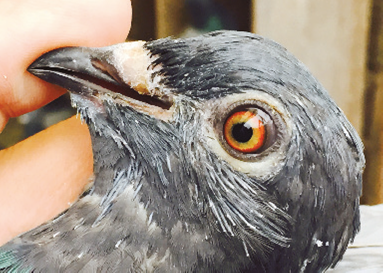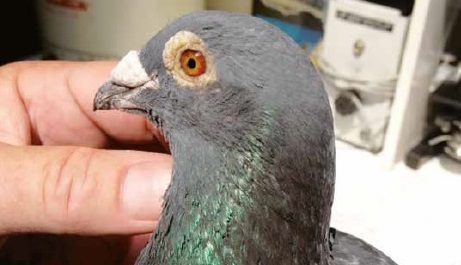

Start of the racing season
The new racing season had barely just begun and after about four flights we see the first problems appearing again. As every year, these are the problems with the upper (front) respiratory tract. We have also come up with a name for it: ‘blocked nasal passage‘.
Blocked nasal passage
In fact, these are small inflammations at the level of the nasal mucous membranes, tear ducts and sinuses (cavities). Often the choana is closed. You should be able to pass a cigarette paper between and it should open when the upper beak is lightly pressed when the mouth is opened!

Often this whole picture is also accompanied by puffed feathers around the ears (‘swollen heads’). At a later stage the pigeons turn blue (blue pectoral muscles) and dry: feathers and muscles. Down shedding also reduces and the pigeons train less enthusiastically and bathe less! We see these problems much more with yearlings than with old birds, and much more with cocks than with hens. There are, of course, a number of understandable reasons for this. Old pigeons have been selected for flight performance longer than yearlings, because the sensitive yearlings are selected out. The fact that hens suffer significantly less from this ornithosis problem – because dry snot is in fact the latent (sub-clinical) form of ornithosis – is because they are much calmer in the shipping baskets and don’t ‘attack’ each other. It goes without saying that they also consume less energy during transport. If hens come home much better than cocks, this means in general, that they suffer less from latent ornithosis than cocks. Many fanciers do not see that their cocks suffer from blocked nasal passage and therefore do not understand that they perform less well. Typical for blocked nasal passage in the initial phase, is the fact that they still come home ‘on the chain’, but simply too late, at the end of the prizes.
If you don’t treat such pigeons against ornithosis and they carry on, things usually get worse every week. Until you start losing good pigeons from relatively easy races. People often think this is because of a lack of condition, but in fact this is due to the slight latent ornithosis infection.
A good loft
The loft plays an important role in all this. It must be dry, a little warm and draught-free. Draughts are very bad for pigeons and lofts are sometimes not good under all weather conditions. Falling air is by definition cold. And if a pigeon sits in it, just as a human being, they’ll automatically get ornithosis or a cold. Learned specialists (doctors) often say ‘no, the cold is a virus and it’s contagious and that is the cause’. True, but for the sake of convenience they forget that these viruses, in the case of a cold in humans, are omnipresent and, as it were, are activated by that draught, and that is just as important. Or, as my wise father always told pigeon fanciers: “sir, if you sit on a motorcycle with wet clothes and you ride for half an hour in the cold, there’s a good chance that you’ll have a cold tomorrow, or the flu”. And that’s exactly how it is: pathogens are just present and are triggered by the circumstances.
Latent ornithosis
That is therefore the most important factor in reducing the form and condition of our pigeons. I wrote that 40 years ago and nothing has changed yet! The causes are mainly bacterial and therefore easily treated. If it was a virus problem, it could not be treated as you understand it. So, herpes viruses play absolutely no role. I say this for the sake of clarity because a lot of people seem to be confused about this! No, the main cause is a Chlamydia infection, the complicating factors of which are Mycoplasma Haemophilus bacteria, Staphylococcus and always E. coli bacteria, and sometimes Tricho.
Excellent, registered veterinary medicines against this latent ornithosis complex are available!
BELGICA DE WEERD B.V. I Postbus 4607 I 4803 EP Breda I Nederland
T +31 76 560 02 22 I F +31 76 565 35 70 I info@belgicadeweerd.com I www.belgicadeweerd.com

